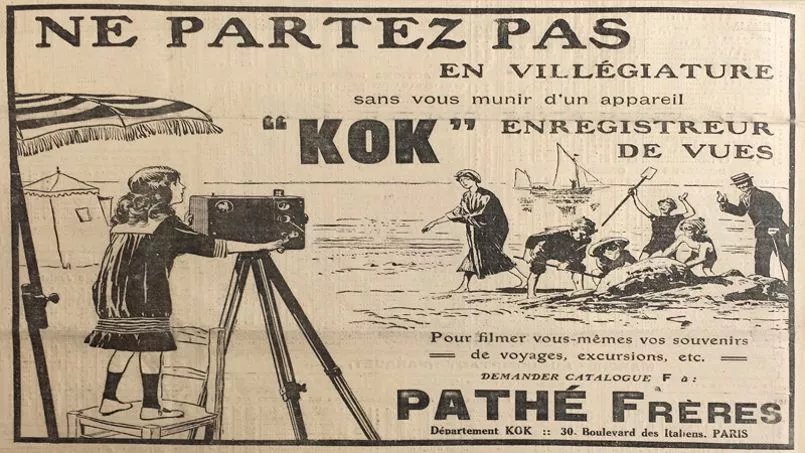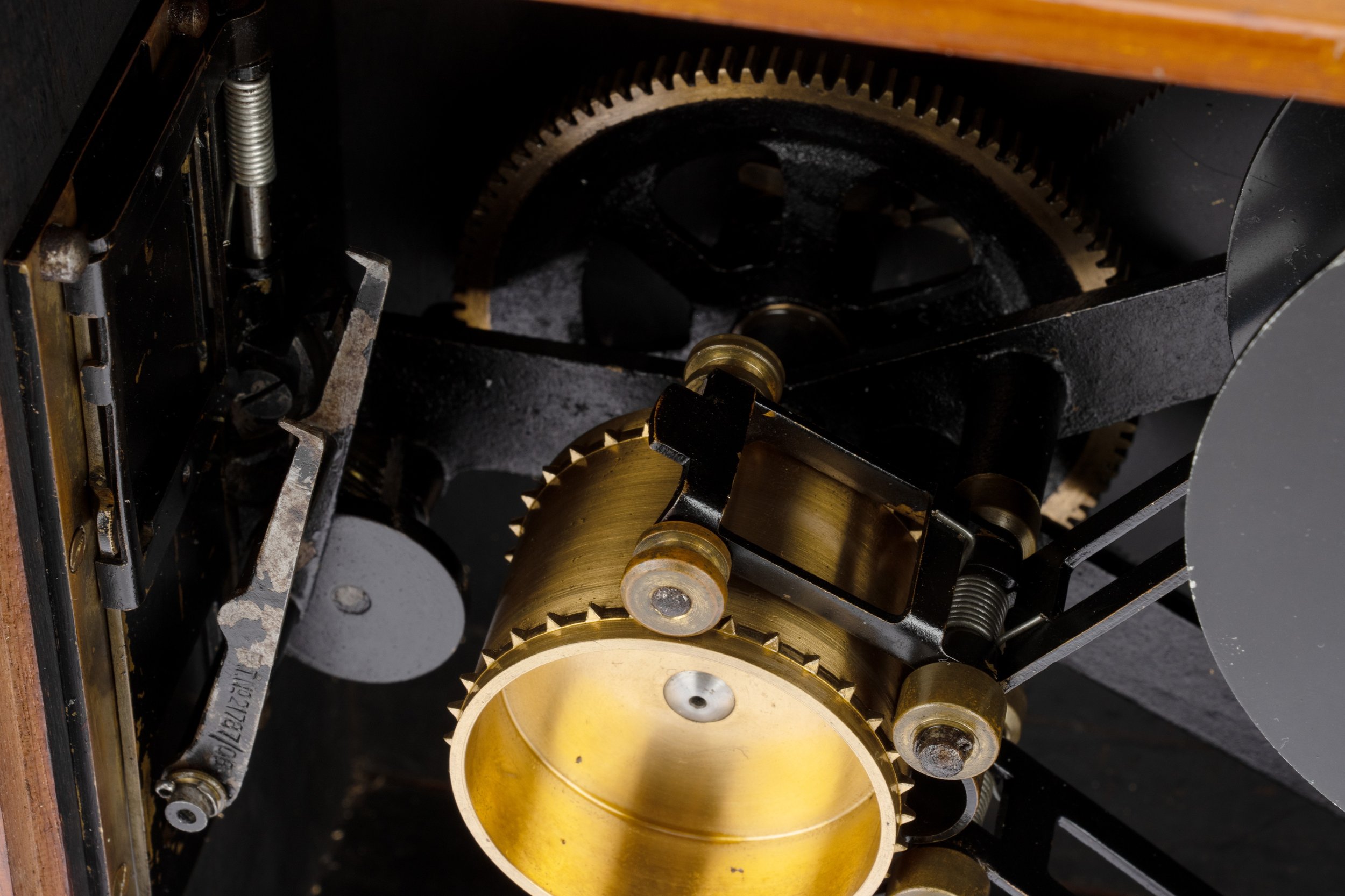Pathé-Frères KOK 28mm Cine Camera
28mm Pathé-Frères KOK Amateur Cine Camera
The Pathe-Feres KOK 28mm camera was introduced in 1912 intended for the amateur market, It was a simplified version of its 35mm brother. Created by Pierre Victor Continsouza in his workshop for Pathe the Kok was equipped with a fixed focus Zeiss Anastigmat lens, a built-in lens cap, a sunshade, iris diaphragm, spirit level, view finder, film length indicator, perforator for marking the end of each take, and contained two 400’ film magazines. The camera measures 12 inches long, 6 inches wide, and 10 inches high, with a weight of just over 13 pounds.
Diagram of the 28 mm Amateur PATHÉ KOK Camera, “Appareil de Prise de Vues Amateur”. Ca. 1912.
Jonathan Silent Film Collection
“The camera is supplied with a Tessar-Krauss lens with a 50 mm focal length and a 1: 3.5 aperture. Additional lenses with a 35 and 75 mm focal lngthss are also supplied with their special mounts on request. The focusing is controlled by means of the lever (6).
Lubrication and maintenance. -
Clean the velvets and places where the film passes with a brush. Scrape the door, the pressure frame and the passages where small particles of gelatin or celluloid could be deposited with a bone or wooden object. Very lightly oil all the bearings and the places where there are grease holes.”
MANUEL CINÉMATOGRAPHE DE SALON 1912
The earlier Pathé Reportage 35mm camera body introduced in same year was the basis for this new KOK 28mm cine camera. The KOK was designed to be hand-cranked on a tripod, like most other movie cameras of the era. On the side of the Kok was a visual indicator which showed when the correct turning speed was achieved to simplify usage for the amateur.
Pathe 35mm Reportage
The KOK camera body was made of leather covered wood with a hinged front panel for access to the lens and a rear cover which opened upwards for full access to the entire film compartment. The supply and take-up spools were in enclosed metal co-axial magazines to permit daylight loading. The main mechanism was mounted on a cast aluminium-alloy centre plate which divided the film compartment from the front mechanism section. Velvet covered pads held the film in engagement with the chain-driven sprockets, which unlike the projector, were symmetrical with three teeth per frame on each edge.
Pathe 28mm print stock
The 28mm negative film had perforations at 5mm pitch on each edge, while the print stock had three perforations on one side and one on the other per frame. The 28mm negative camera film was nitrate stock, only the positive print was on safety stock.
“No elaborate directions are needed. There is even an automatic indicator showing just the right speed at which to turn the crank.”
The side-by-side film loading arrangement required a partly twisted lower loop. A soft velvet covered guide started the film in this loop as it left the gate. Intermittent motion was achieved by a claw pull-down with a single claw on either side of the film. A double cam oscillated the claw frame on its vertical guides, extending the claws on pull-down stroke and withdrawing them on the return stroke.
The camera body hinges upwards to access the film magazines.
In the front section of the camera the driving shaft was geared to the claw and shutter mechanism and to the chain drive for the sprockets. A supplementary gear train operated both the footage counter and the centrifugal actuator of the speed indicator. A punch for marking the film was operated by a knob on the side of the front section. On top of the camera the viewfinder comprised a front diverging element with cross-lines and a rear peep sight. Near the front finder lens was a red bubble level.
45mm f4.5 Anastigmat Lens
The camera lens, a 45mm f4.5 anastigmat in a helical mount, lacked a focussing scale and was intended for simplicity and set at its hyperfocal distance for normal use. Optionally, it could be critically focussed with the addition of a screen applied to the film gate from the film compartment.
The Pathe Kok 28mm camera was available beginning in late 1912 at the advertised price of 440 francs including a tripod, which was essential as the camera is quite large. Their advertising almost makes fun of the size depicting a child on a chair barely reaching the hand crank as she films her family.
1912 Pathe KOK Advertising
At the time of launch the reversal process had not been introduced, so negative 28mm film stock was offered in a 394 foot spool. The exposed spool of film was returned to Pathéscope for processing and production of a positive projection print at which point the safety film was introduced. This was the main point of focus for Pathe’s advertising.
The camera was prohibitively expensive, which meant Pathe had to market the system as an elite product. Targeting mostly an affluent audience they offered a complete system including a safety projector and library of films, all marketed as the “cinematographe de salon”.
“Although new to America, Pathescopes already graced many of the finest homes.”
Due to the cameras size and the costs associated with film and processing sales never meet expectations, the camera was a commercial failure with less the 500 units produced. Known camera serial numbers dont exceed three digits and the first known example starts at serial number 501.
“Among the Royal Pathescope patrons are the Czar of Russia, the King of Belgium, the King of Spain, the King of Italy, the King of Siam, and the Sultan of Morocco.”
Pathescope Co. of America
c1919 Pathescope Co. of America - Pathe Laboratories
Meanwhile in the United States, Pathéscope Company of America marketed a motor-driven version of the Kok projector in 1913. They also introduced a much smaller 28mm camera called the New Premier Daylight Loading Safety Standard Motion Picture Camera. Despite its extremely long name, it was a very simple camera taking 100’ daylight loading spools.
Two models were described in their catalog: the "DeLuxe" model was supplied with a Aldis-Butcher Anastigmat f/3.1 - 1.7” lens in focusing mount, the camera covered in genuine Morocco leather; the "Favorite" model was covered in imitation leather, and came with a fixed-focus f/7.7 lens.
Pathescope Co. of America DeLuxe model 28mm camera (sn 624)
The American Pathescope was far more successful than its French counterpart, although the 28mm format would only survive a few more years and by 1920 it was completely absent from the market.
Stay tuned to my next Blog post where I will discuss the similarities between this 28mm Pathescope of America Cinematograph and the British made 35mm Houghton Ensign Cinematograph. Both utilizing the same movement and nearly identical designs.
Houghton Ensign 35mm Cinematograph
French and American Marketing, 1912-1913
LITERATURE:
28mm Pathé-Frères KOK Cine Camera Operations Manual [1912]
Histoire du Cinématographe de ses origines jus’a nos jours, G.M. Coissac [1925]
Histoire de la caméra ciné amateur, Michael Auer [1979]
Ariel Cinematographic Register, Band 1, no.223., Peter Ariel [1989]
Home Movies- A history of the American Industry, 1897-1979, Alan Kattelle [2000]
Amateur Movie Making Aesthetics of the Everyday in New England Film, 1915–1960 [2017]
Projecteurs & Cameras La collection de la Fondation, Jerome Seydoux-Pathe [2024]
















